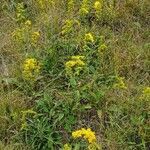Plants 1–10 dm from a branched caudex; herbage densely and finely puberulent with minute, loosely spreading hairs; lvs basally disposed, weakly or scarcely triple-nerved, the larger ones oblanceolate or a bit wider, 5–25 × 0.8–4 cm, ± toothed; infl paniculiform, sometimes long, narrow, and merely nodding at the tip, varying to more ample and sometimes with long divergent, recurved-secund branches; invol bracts imbricate, glabrous except for the ciliolate margins; rays 5–9, short; disk-fls 3–6; achenes short-hairy; 2n=18, 36. Dry woods and open places, especially in sandy soil; N.S. to Fla., w. to Alta. and Tex. Three vars.
A herb.







